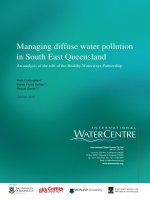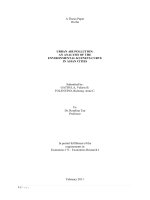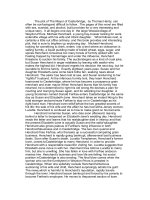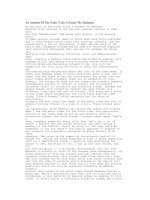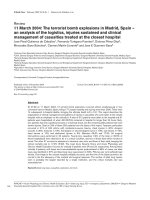An analysis of the evaluative language in news about islamic states on cable news network (CNN) and channel news asia (CNA) from november 30, 2014 to december 10, 2014 in light of appraisal theory
Bạn đang xem bản rút gọn của tài liệu. Xem và tải ngay bản đầy đủ của tài liệu tại đây (1.06 MB, 106 trang )
VIETNAM NATIONAL UNIVERSITY HANOI
UNIVERSITY OF LANGUAGES AND INTERNATIONAL STUDIES
POST GRADUATE DEPARTMENT
********************
NGUYỄN MAI LÊ
AN ANALYSIS OF THE EVALUATIVE LANGUAGE IN NEWS
ABOUT ISLAMIC STATES ON CABLE NEWS NETWORK (CNN)
AND CHANNEL NEWS ASIA (CNA) FROM NOVEMBER 30, 2014 TO
DECEMBER 10, 2014 IN LIGHT OF APPRAISAL THEORY
(Phân tích ngôn ngữ đánh giá trong các bản tin về nhà nước Hồi giáo
trên CNN và CNA từ ngày 30/11/2014 đến ngày 10/12/2014 dựa trên
thuyết thẩm định)
M.A MINOR PROGRAMME THESIS
Field: English linguistics
Code: 60220201
HANOI – 2015
VIETNAM NATIONAL UNIVERSITY HANOI
UNIVERSITY OF LANGUAGES AND INTERNATIONAL STUDIES
POST GRADUATE DEPARTMENT
********************
NGUYỄN MAI LÊ
AN ANALYSIS OF THE EVALUATIVE LANGUAGE IN NEWS
ABOUT ISLAMIC STATES ON CABLE NEWS NETWORK (CNN)
AND CHANNEL NEWS ASIA (CNA) FROM NOVEMBER 30, 2014 TO
DECEMBER 10, 2014 IN LIGHT OF APPRAISAL THEORY
(Phân tích ngôn ngữ đánh giá trong các bản tin về nhà nước Hồi giáo
trên CNN và CNA từ ngày 30/11/2014 đến ngày 10/12/2014 dựa trên
thuyết thẩm định)
M.A MINOR PROGRAMME THESIS
Field: English linguistics
Code: 60220201
Supervisor: Nguyễn Thị Minh Tâm, Ph.D
HANOI – 2015
ACCEPTANCE
I hereby state that I: Nguyen Mai Le from group K22B, ULIS, VNU, being
a candidate for the degree of Master of Arts, accept the requirements of the
University relating to the retention and use of Master‟s Graduation Paper deposited
in the library.
In terms of these conditions, I agree that the origin of my paper deposited in
the library should be accessible for the purpose of study and research, in accordance
with the normal conditions established by the librarians for the care, loan or
reproduction of the paper.
Hanoi, July 15th 2015
Nguyen Mai Le
i
ACKNOWLEDGEMENT
This thesis would not have been possible without the generous support from many
people.
First and foremost, I would like to show my deepest gratitude to my supervisor,
Nguyen Thi Minh Tam, Ph.D, who enthusiastically followed, checked, and gave
constructive comments on my work. Without her valuable guidance and expertise
during the writing process, I would not be able to reach the thesis completion today.
In addition, I am truly grateful to all teachers in Postgraduate Department, ULIS,
VNUH for their devotion to providing me with deep English linguistics knowledge
and precious consultancy. To me, they are a true inspiration for my pursuit of the
career after graduation.
Last but not least, I am eternally indebted to my family – my parents and my brother
– and my close friend Pham Thuy Mai, who exhorted me to start the thesis and
cheered me during the process.
ii
ABSTRACT
The research focuses on exploring evaluative language in news about IS on CNN
and CNA from November 30, 2014 to December 10, 2014 in the light of Appraisal
theory. With careful investigation, the paper finds out how evaluative language is
realized in news and points out similarities and differences between writers‟
journalistic stances on CNN and writers‟ journalistic stances on CNA about IS.
Additionally, the paper offers suggestions for further studies in the given topic. For
accomplishments of these objectives, content analysis and statistical analysis are
employed as data analysis instruments. Despite the writer‟s sustained efforts and
serious work, the paper cannot avoid shortcomings. The writer hopes that this study
will make a small contribution to translation studies and translation training.
iii
TABLE OF CONTENT
Acceptance .................................................................................................................. i
Acknowledgement .....................................................................................................ii
Abstract .................................................................................................................... iii
Table of content ........................................................................................................ iv
List of abbreviations ............................................................................................... vi
List of figures and tables.........................................................................................vii
PART A: INTRODUCTION.......................................................................... 1
1.1.
Rationale for the study .................................................................. 1
1.2.
Aims and objectives of the study .................................................. 2
1.2.1.
Aims of the study ..................................................................... 2
1.2.2.
Objectives of the study............................................................. 2
1.3.
Research questions ........................................................................ 2
1.4.
Scope of the study ......................................................................... 2
1.5.
Methods of the study ..................................................................... 3
PART B: RESEARCH CONTENT ............................................................... 4
CHAPTER 1: LITERATURE REVIEW.................................................. 4
1.1. Evaluative language ........................................................................... 4
1.1.1. Appraisal theory .......................................................................... 4
1.1.2. Evaluative language .................................................................... 6
1.1.3. Appraisal resources ..................................................................... 7
1.2. Attitude in Appraisal theory ............................................................... 8
1.2.1. Affect........................................................................................... 8
1.2.2. Judgment ................................................................................... 11
1.2.3. Appreciation .............................................................................. 11
1.3. Related studies ................................................................................. 12
iv
CHAPTER 2: METHODOLOGY........................................................... 14
2.1. Research Method and the Corpus .................................................... 14
2.2. Data analysis instruments................................................................. 16
CHAPTER 3: FINDING AND DISCUSSION........................................... 17
3.1. Statistical findings ............................................................................ 17
3.2. Qualitative findings .......................................................................... 21
3.2.1. Headlines analysis ..................................................................... 22
3.2.2. Article content analysis ............................................................. 23
PART C: CONCLUSION............................................................................. 35
1. Main findings of the study ...................................................................... 35
1.1. The evaluative language is realized in the news about IS on CNN
and CNA .................................................................................................. 35
1.2. Similarities and differences between writers‟ journalistic stances on
CNN and writers‟ journalistic stances on CNA about IS ....................... 35
1.2.1. Similarities between writers‟ journalistic stances on CNN and
writers‟ journalistic stances on CNA about IS .................................... 35
1.2.2. Differences between writers‟ journalistic stances on CNN and
writers‟ journalistic stances on CNA about IS .................................... 36
2. Suggestions for further studies ................................................................ 37
3. Limitations of the study .......................................................................... 37
4. Contributions of the study ....................................................................... 38
REFERENCES .............................................................................................. 39
APPENDIX
I
v
LISTS OF ABBREVIATIONS
CNN
Cable News Network
CNA
Channel News Asia
E.g.
Example
IS
Islamic States
+
Positive attitude
-
Negative attitude
vi
LISTS OF FIGURES AND TABLES
Page
Figure 1:
An overview of Appraisal resources
7
Figure 2:
A summary of percentage of Affect in news on CNN and
17
CNA (‰)
Figure 3:
A summary of percentage of Judgment in news on CNN and
19
CNA (‰)
Figure 4: A summary of percentage of Appreciation in news on CNN
20
and CNA (‰)
Table 1:
Grammatical realizations of Affect
9
Table 2:
Sub-categories of Affect
10
Table 3:
Affect- Un/happiness, in/security, dis/satisfaction
11
Table 4:
Judgment
11
Table 5:
Appreciation
12
Table 6:
Articles on CNN
15
Table 7:
Articles on CNA
16
Table 8:
Distribution of Appraisal resources on CNN and on CNA
17
vii
PART A: INTRODUCTION
1.1.
Rationale for the study
It is undeniable that language plays an important role in life of human
beings. Language can be used to express the writer's/speaker's opinion on people,
things and situations. For the past several years, there have been many attempts to
study the linguistic mechanisms employed by speakers and writers to convey their
personal feelings and assessments. Such investigations have been carried out using
a wide range of conceptual and theoretical approaches, including stance (Biber,
2006), metadiscourse (Hyland & Tse, 2004), evaluative, attitudinal or affective
language (Ochs, 1989), evidentiality (Chafe & Nichols, 1986), and evaluation
(Hunston, 1994; 2011). Especially, Martin and White (2005) developed an elaborate
system called Appraisal theory allowing linguistic analysis of a text from the
perspective of the evaluative properties of this text. The Appraisal theory is
concerned with a) how text producers (writers or speakers) construe particular
authorial identities for themselves, b) how authors align or do not align themselves
with actual or potential respondents, and c) how writers or speakers construct an
ideal audience for their texts (Martin & White, 2005; Pankovskyi, 2013). This
approach is related to the stance, language usage, and response. The Appraisal
theory is thus suitable to be employed to analyze and evaluate living language in
journalistic discourse with diverse topics and numerous audiences.
In addition, events of Islamic States (IS) are drawing attention of politicians‟
and scholars‟ interest with various understandings and thoughts because their
instability has affected international security. Therefore, quite a few articles are
published daily to update Islamic states‟ events.
Moreover, up to now, very few or even no research has been done to explore
the evaluative language in news about Islamic States. Because of aforementioned
conditions, in this research, I would like to utilize two famous channels CNN (an
1
American channel) and CNA (an Asian channel) to compare the use of evaluative
language in news about IS and to compare writers‟ journalistic stances on these
channels.
1.2.
Aims and objectives of the study
1.2.1. Aims of the study
In this study, the writer aims at analyzing the evaluative language in news
about Islamic States on CNN and CNA from November 30, 2014 to December 10,
2014 in the light of appraisal theory.
1.2.2. Objectives of the study
The study focuses on two objectives. The first objective is to describe how
evaluative language is realized in in news about Islamic States on CNN and CNA
from November 30, 2014 to December 10, 2014 in the light of Appraisal theory.
The second objective is to compare writers‟ journalistic stances on CNN and
writers‟ journalistic stances on CNA hidden in their expressions.
1.3. Research questions
To reach aforementioned objectives, the study answers two research
questions:
- Question 1: How is evaluative language realized in news about Islamic States on
CNN and CNA from November 30, 2014 to December 10, 2014?
- Question 2: What are the similarities and differences between writers’
journalistic stances on CNN and writers’ journalistic stances on CNA about IS?
1.4. Scope of the study
As the title of the whole study, this paper places a strong focus on two issues.
The first issue is to investigate the use of evaluative language in news about Islamic
States on CNN and CNA from November 30, 2014 to December 10, 2014. Under
2
the three systems of Appraisal Framework, attention will be mainly paid to the
application of attitude, which also encompasses three categories: affect, judgment
and appreciation which belong respectively to psychology and emotional world,
ethics and human behavior and nonhuman behavior. Little attention will be paid to
engagement and graduation in this article.
The writer chose news from these two channels because CNN and CNA are
two famous channels of America and Singapore respectively. The writer hopes that
news about IS released in these two channels will bring different nuances to the
study. Besides, Islamic States‟ events are momentous events that draw everyone‟s
attention in the world so news about Islamic States is always updated and
unpredictable. Therefore, the writer just chose the news released for ten days from
November 30, 2014 to December 10, 2014 with 10 and 10 articles on CNN and
CNA respectively.
1.5. Methods of the study
In the study, qualitative method is used with the instruments of content
analysis and statistical analysis. Comparative method is also used to compare
writers‟ journalistic stances on CNN and writers‟ journalistic stances on CNA.
Besides, CoSchedule website is employed to analyze headlines. CoSchedule is a
website that more than 10000 bloggers, editors, and social marketers trust to plan
their blog, content, marketing, and social media.
3
PART B: RESEARCH CONTENT
CHAPTER 1: LITERATURE REVIEW
1.1. Evaluative language
1.1.1. Appraisal theory
The Appraisal theory has grown out of the functional perspective in
linguistics. Functional grammar perceives language as having three meta-functions,
namely, ideational, interpersonal and textual. The interpersonal meta-function is
concerned with interaction between the addresser and addressee in the discourse
situation and with the addresser‟s attitude toward what he speaks or writes about.
Halliday (2004) pinpoints mood, modality and key as major exponents of
interpersonal meaning. In his Introduction to Functional Grammar, he mentioned
the existence of other means of realizing interpersonal meaning but even these
cannot be exhaustive. By emphasizing the semantics of evaluation, the Appraisal
theory has opened up a new area of interpersonal meanings. In this theory, Martin
and White (2005) discuss how to use language to express emotion, ethics and
aesthetic value.
Martin and White (2005) explain that the Appraisal theory is based on the
notion of stance: “appraisal is probably most closely related to the concept of
stance” (p. 40), which depends heavily on the idea that “whenever speakers (or
writers) say anything, they encode their point of view towards it” (p. 92). Besides,
Appraisal framework is an approach which enables to explore, describe and explain
“the way language is used to evaluate, to adopt stances, to construct textual
personas and to manage interpersonal positionings and relationships” (White,
2005). By means of this approach it is possible to identify attitudes,
judgments and emotive responses that are “explicitly presented in texts” as well as
those which are “indirectly implied, presupposed or assumed” (White, 2005).
The Appraisal theory sees declarations of attitude as “dialogically directed towards
4
aligning the addressee into a community of shared values and belief” (Martin &
White, 2005, p. 95). Thus, declarations of attitude not only serve the purpose of
stance taking by communicating the author„s own attitude, but are also oriented
towards aligning the listener/reader into an axiological community by offering to
share the author‟s attitude (Pankovskyi, 2013). In other words, the Appraisal theory
analyzes how the writer‟s/speaker‟s attitude is expressed and how it is directed
towards aligning the reader/listener into a community of shared values and belief.
For example, often, the author does not state overtly his/her position, but the
Appraisal theory allows an analyst still to discern it through the analysis of the
author‟s use of language of evaluation.
Moreover, this approach is thus suitable for the thesis as its aim is to look at
journalistic discourse and find out whether and to what extent journalists use
evaluative language. In this study, I choose journalistic discourse to analyze the
evaluative language because of typical characteristics of journalistic discourse. Bell
(1995, p.23-41) provides four reasons for the attention paid to journalistic discourse,
“First, the media provide an easily accessible source of language data for research
and teaching purposes. Second, the media are important linguistic institutions. Their
output makes up a large proportion of the language that people hear and read
every day. Media usage reflects and shapes both language use and attitudes in a
speech community. For second language learners, the media may function as the
primary or even the sole source of native-speaker models. Third, the ways in which
the media use language are interesting linguistically in their own right; these include
how different dialects and languages are used” by different segments of media
“to construct their own images and their relationships to an unseen, unknown
audience. Fourth, the media are important social institutions. They are crucial
presenters of culture, politics, and social life, shaping as well as reflecting how
these are formed and expressed.” (p.23). Various products of media are indeed all
around us and touch perhaps every sphere of our life and as Bell (1995) maintains
they influence our views. Besides, the topic in journalistic discourse is very various
5
from the trifles to important things. The language in the articles is considered
carefully. Fowler (1991) says that this is indeed what journalists in general claim,
i.e. that “he or she collects facts, reports them objectively, and the newspaper
presents them fairly and without bias, in language which is designed to be
unambiguous, undistorting and agreeable to readers. This professional ethos is
common to all the news media…” (Fowler, 1991: 1).
1.1.2. Evaluative language
Moving deeper into the way language is used, “evaluative language” is one
of the available resources at the lexical and grammatical level that are used to
reflect, instantiate, and maintain role relationships between people. For example,
while one can say that “the man drove the car,” if one said “the maniac drove the
car,” this puts a particular slant on someone driving a car and conveys a lot
of
what
is
termed
“interpersonal” meaning, rather than purely referential
meaning. Evaluative language is the linguistic expressions that indicate “the
subjective presence of writers/speakers in texts as they adopt stances towards both
the material they present and those with whom they communicate” (Martin and
White 2005: 1). Evaluative meanings (Labov, 1972; Martin & White, 2005/2007)
can be expressed through nouns (e.g., idiot, maniac), verbs (e.g., raced,
enthused), adjectives (e.g., fantastic, horrible), intensifiers (e.g., very, clearly),
or complete phrases or clauses (e.g., without a doubt). If one examines this kind of
language, it can be seen that it is this emotive or opinionated language that enables
speakers to assert who they are (i.e., their identity) and what their perspective on
events is. In Thompson and Hunston‟s words, evaluative language involves
linguistic devices that “express the speaker‟s or writer‟s opinion, and in doing so …
reflect the value system of that person and their community” (Thompson &Hunston,
2000, p.6).
The purpose of evaluative language is also “to construct and
maintain relations between the speaker or writer and hearer or reader” (p.6).
6
1.1.3. Appraisal resources
The Appraisal theory has a ramified structure allowing it to recognize even
slight expressions of attitude. Three main resources of the framework are:
ENGAGEMENT, ATTITUDE, and GRADUATION.
Figure 1: An overview of Appraisal resources (Martin &White, 2005, p.38)
1) ENGAGEMENT is “directed towards identifying the particular dialogic
positioning associated with given meanings and towards describing what
is at stake when one meaning rather than another is employed” (Martin &
White, 2005, p. 97).
2) ATTITUDE is “concerned with our feelings, including emotional
reactions, judgments of behavior and evaluation of things” (Martin &
White, 2005, p. 35). It consists, in turn, of three resources: AFFECT,
JUDGEMENT, and APPRECIATION.
a) AFFECT – Affect deals with resources for construing emotional
reactions; (Martin & White, 2005, p. 35).
7
b) JUDGEMENT – Judgment is concerned with resources for assessing
behavior according to various normative principles; (Martin & White,
2005, p. 35).
c) APPRECIATION – Appreciation looks at resources for construing the
value of things, including natural phenomena and semiosis (as either
product or process) (Martin & White, 2005, p. 35).
3) GRADUATION deals with “grading phenomena whereby feelings are
amplified and categories blurred” (Martin & White, 2005, p. 35). It is
divided into two major resources: FORCE and FOCUS.
a) FORCE – resources used as “adjustments” of the degree of
evaluations;
b) FOCUS – resources used in the non-gradable context, it “has the effect
of adjusting the strength of boundaries between categories, constructing
core and peripheral types of things” (Martin & White, 2005, p. 37).
In summary, the Appraisal theory is based on the concept of stance. The
Appraisal theory is oriented towards uncovering the author‟s attitude and the way in
which texts align with a potential or real reader/listener.
1.2. Attitude in Appraisal theory
1.2.1. Affect
1.2.1.1. Grammatical Realizations of Affect
Types
Grammatical function
Epithet
(describing
participants)
Quality
Attribute
(attributed
to
participants)
Circumstance (manner of
processes)
8
Example
A happy man
He was sad
He left happily
Process:
Process (effective)
He liked her.
Process (middle)
She pleased him.
-
Affective mental
-
Affective behavioral Process
He smiled.
Comment
-
Desiderative
Modal adjunct
Happily, he won.
Table 1: Grammatical realizations of Affect (Martin &White, 2005, p.46)
1.2.1.2. Sub-categories of Affect
1. Positive
Negative
E.g.: The captain was happy.
E.g.: The captain was sad.
2. Behavioral surge
Mental process
E.g.: The captain wept.
E.g.: The captain disliked leaving/the
captain felt sad.
3. Reaction to other
E.g.:
The
leaving/leaving
Undirected mood
captain
disliked E.g.: The captain was sad.
displeased
the
captain.
4. Low
Median
E.g.: the captain disliked leaving
E.g.:
The
High
captain E.g.:
hated leaving.
5. Realis
The
captain
detested leaving.
Fear
E.g.:
E.g.: tremble, wary,
The captain disliked leaving.
shudder
Irrealis
fearful,
cower, terrorized
Desire
E.g.: suggest, miss,
request,
9
long for,
demand, yearn for
6. Un/happiness
In/security
Dis/ satisfaction
Table 2: Sub-categories of Affect (Martin &White, 2005, p.46-48)
The sixth category is complicated so it is displayed below:
Misery
Unhappiness
Antipathy
Un/happiness
Cheer
Happiness
Affection
Disquiet
Insecurity
Surprise
In/security
Confidence
Security
Trust
Ennui
Dissatisfaction
Displeasure
Dis/satisfaction
Satisfaction
Interest
10
whimper, cry, wail, down, sad,
miserable,…
rubbish, abuse, revile, dislike, hate,
abhor,…
chuckle, laugh, rejoice, cheerful,
buoyant, jubilant,…
shake hands, hug, embrace, be fond of,
love, adore,…
restless, twitching, shaking, uneasy,
anxious, freaked out,…
start, cry out, faint, startled, jolted,
staggered,…
declare, assert, proclaim, together,
confident, assured,…
delegate, commit, entrust, comfortable
with, confident in/about, trusting,…
fidget, yawn, tune out, flat, stale,
jaded,…
caution, scold, castigate, cross, angry,
furious,…
attentive, busy, industrious, involved,
absorbed, engrossed,…
Pleasure
pat on the back, compliment, reward,
satisfied, pleased, chuffed,…
Table 3: Affect- Un/happiness, in/security, dis/satisfaction
(Martin and White, 2005, p.51)
1.2.2. Judgment
Positive (admire)
Social esteem
Negative (criticize)
Normality
luck, natural,
unlucky, odd,
(How special?)
predictable …
unpredictable …
Capacity
powerful, healthy,
mild, sick, immature …
(How capable?)
mature …
Tenacity
brave, patient,
(How dependable?) thorough …
cowardly, impatient,
reckless …
Positive (praise)
Negative (condemn)
Veracity [truth]
truthful, frank, discrete
dishonest, deceptive,
(How honest?)
…
blunt …
sanction
Propriety [ethics]
moral, fair, sensitive
evil, unfair, insensitive
(moral)
(How far beyond
…
…
Social
reproach?)
Table 4: Judgment (Martin and White, 2005, p.53)
1.2.3. Appreciation
Positive
11
Negative
Reaction:
asserting, lively,
dull, monotonous,
Impact “Did it grab
remarkable …
unremarkable …
fine, lovely, appealing …
bad, ugly, repulsive …
Composition:
balanced, consistent,
unbalanced, contradictory,
Balance “Did it hang
shapely …
shapeless …
clear, precise, intricate …
unclear, wooly, plain …
Valuation:
penetrating, innovative,
shallow, conventional,
“Was it worthwhile?”
timely …
overdue …
me?”
Reaction:
Quality “Did I like it?”
together?”
Composition:
Complexity “Was it
hard to follow?”
Table 5: Appreciation (Martin and White, 2005, p.56)
1.3. Related studies
There have been many studies on evaluative language using Appraisal
framework in different specific discourses.
In the study “Appraisal Perspective on Attitudinal Analysis of Public Service
Advertising Discourse”, Hai-bin Wu (2013) analyzed the attitudinal meaning of
public service advertising discourse using the appraisal framework with a view to
revealing how linguistic elements realizes the appraisal meaning and especially
what attitudinal value is of frequent occurrence in the target discourse.
A‟Beckett wrote a paper (2009) entitled Appraisal in the Russian Press: the
Characterization of the Ukrainian Leaders in which she does what she says as
“uncover the means of inviting negative perception of Ukrainian leaders in the
Russian Press” (p.1). To achieve this, she uses Appraisal theory for the analysis of
12
evaluative language to analyze texts of Russian newspapers. This paper is especially
helpful in understanding how the Appraisal theory works on newspaper texts to
reveal emotional elements in what is commonly regarded as objective news.
Martin, in his article in the Discourse and Society journal entitled Mourning:
How We are Aligned, examines appraisal elements in the September 2001
edition of a Hong Kong-based magazine‟s editorial entitled Mourning. In it, he
shows how the editorial uses Appraisal resources to have the readers
sympathize with the unfortunate persons told in the editorial, to align the
readers with the position and opinion of the writer(s) of the editorial.
In spite of the fact that there have been many studies on evaluative language
using Appraisal framework in different kinds of discourse mentioned above, very
few even no studies on evaluative language in news concerning Islamic States.
Therefore, the researcher hopes that this research could provide an in-depth analysis
of evaluative language in this topic in light of Appraisal theory.
13
CHAPTER 2: METHODOLOGY
2.1. Research Method and the Corpus
The study is conducted in corpus-based approach. Research data in this study
is news about Islamic States on CNN and CNA from November 30, 2014 to
December 10, 2014.
Cable News Network (CNN) which was established on June 1, 1980 is
an American basic cable and satellite television channel. As of August 2013, CNN
is available to approximately 98,496,000 cable, satellite and Telco television
households (86% of households with at least one television set) in the United States.
Channel News Asia (CNA): was established on March 1 1999 by Media
Corp, and is an Singaporean English language Asian cable television news
agency and news channel. Positioned to “Understand Asia”, it reports on global
developments with Asian perspectives.
Because of their fame, pervasiveness, and easy accessibility, these two
channels give a guarantee of research data.
The corpus is compiled from 10 articles on CNN which are coded CNN1,
CNN2,…CNN10
and
10
articles
on
CNA
which
are
coded
CNA1,
CNA2,…CNA10 from November 30, 2014 to December 10, 2014. The corpus is
presented in the table below.
Articles
CNN1
CNN2
CNN3
Name
Suspected ISIS militants kill 16 Iraqi
border guards
Airstrikes mark shift in coalition focus
to ISIS “capital”
“Powerful” wife of ISIS leader AlBaghdadi arrested in Lebanon
14
Words
Day retrieved
110
December 1, 2014
330
December 1, 2014
820
December 2, 2014
CNN4
CNN5
CNN6
CNN7
CNN8
CNN9
FBI warns military of ISIS threat
Pentagon: There are “indications” that
Iran bombed ISIS in Iraq
Syrian president: U.S.- led airstrikes
have cause “no change” in ISIS strength
Mystery surrounds arrest of woman
who may be ISIS leader‟s wife
Life in the rubble of Kobani
UAE woman arrested in U.S. teacher‟s
mall restroom stabbing
489
December 2, 2014
646
December 3, 2014
705
December 3, 2014
1067
December 3, 2014
614
December 4, 2014
681
December 5, 2014
573
December 5, 2014
Free my brother free my son U.S.
CNN10
family pleas with Al Qaeda for Luke
Somers‟ life
Table 6: Articles on CNN
Articles
CNA1
CNA2
CNA3
CNA4
CNA5
CNA6
Name
Words
Islamic State militants suffer heavy
losses in Syria‟s Kobane
Islamic State militants kill 16 border
guards in Western Iraq
Islamic State advance “being halted”:
coalition
Anti- Islamic State fight will take
“years”, says Kerry
Kerry hosts first coalition meeting to
discuss strategy against Islamic State
IS advance in East Syria kills 19
15
765
398
184
772
713
196
Retrieved
November
30,
2014
December
02,
2014
December
03,
2014
December
03,
2014
December
03,
2014
December
04,
troops, militia: monitor
CNA7
CNA8
CNA9
CNA10
19
killed
in
2014
Islamist
attack
in
Chechnya
Islamic State has training camps in
Eastern Libya: US general
EU counts on intelligence sharing to
stem foreign fighters‟ flow to Syria
Allies to send 1500 security personnel
to Iraq: US
692
380
709
733
December
04,
2014
December
04,
2014
December
09,
2014
December
09,
2014
Table 7: Articles on CNA
2.2. Data analysis instruments
In the study, content analysis is used as a major instrument to find out the
answers to research questions. Also, statistical analysis is employed to find out the
general trend in the use of evaluative language by writers on CNN and CNA.
16


